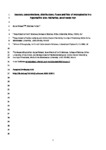Sources, concentrations, distributions, fluxes and fate of microplastics in a hypersaline lake: Maharloo, south-west Iran
| dc.contributor.author | Abbasi, S | |
| dc.contributor.author | Turner, Andrew | |
| dc.date.accessioned | 2022-05-04T15:52:20Z | |
| dc.date.issued | 2022-06-01 | |
| dc.identifier.issn | 0048-9697 | |
| dc.identifier.issn | 1879-1026 | |
| dc.identifier.other | 153721 | |
| dc.identifier.uri | http://hdl.handle.net/10026.1/19184 | |
| dc.description.abstract |
Hypersaline lakes support unique ecosystems and biogeochemistries but are often subject to anthropogenic pressures from pollution, water abstraction-diversion and climate change. Less understood, however, are the inputs, distributions and impacts of microplastics (MPs) in hypersaline environments. In this study, MPs are determined in water and sediment cores of Maharloo Lake, south-west Iran, and in the anthropogenically-impacted rivers that recharge the lake. MP concentrations in river water ranged from 0.05 MP L-1 in the headwaters to about 2 MP L-1 downstream of industrial effluents, with intermediate (but elevated) concentrations observed in the lake. The maximum surface concentration in lake sediment cores was about 860 MP kg-1, and concentrations displayed a progressive reduction with increasing depth down to 50 cm that are qualitatively consistent with temporal changes in plastic production. The size distribution of MPs was skewed towards the finest fraction (< 100 μm) and the most abundant polymer types were polyethylene terephthalate, polyethylene and nylon. Flux calculations using river water data and published atmospheric deposition data for the region reveal that the atmosphere is, by at least an order of magnitude, the more important source. MPs added to the lake appear to be maintained in suspension by high density water but are subsequently deposited to sediments by encapsulation and nucleation as salts precipitate. In addition, it is proposed that direct atmospheric deposition to sediment takes place on areas that seasonally dry out and are subsequently inundated. The impacts of MPs on hypersaline ecosystems and biomass resources are unknown but warrant investigation. | |
| dc.format.extent | 153721-153721 | |
| dc.format.medium | Print-Electronic | |
| dc.language | en | |
| dc.language.iso | eng | |
| dc.publisher | Elsevier | |
| dc.subject | Rivers | |
| dc.subject | Sediments | |
| dc.subject | Polymers | |
| dc.subject | Brine | |
| dc.subject | Density | |
| dc.subject | Deposition | |
| dc.title | Sources, concentrations, distributions, fluxes and fate of microplastics in a hypersaline lake: Maharloo, south-west Iran | |
| dc.type | journal-article | |
| dc.type | Journal Article | |
| plymouth.author-url | https://www.webofscience.com/api/gateway?GWVersion=2&SrcApp=PARTNER_APP&SrcAuth=LinksAMR&KeyUT=WOS:000766797600001&DestLinkType=FullRecord&DestApp=ALL_WOS&UsrCustomerID=11bb513d99f797142bcfeffcc58ea008 | |
| plymouth.volume | 823 | |
| plymouth.publication-status | Published | |
| plymouth.journal | Science of the Total Environment | |
| dc.identifier.doi | 10.1016/j.scitotenv.2022.153721 | |
| plymouth.organisational-group | /Plymouth | |
| plymouth.organisational-group | /Plymouth/Faculty of Science and Engineering | |
| plymouth.organisational-group | /Plymouth/Faculty of Science and Engineering/School of Geography, Earth and Environmental Sciences | |
| plymouth.organisational-group | /Plymouth/REF 2021 Researchers by UoA | |
| plymouth.organisational-group | /Plymouth/REF 2021 Researchers by UoA/UoA07 Earth Systems and Environmental Sciences | |
| plymouth.organisational-group | /Plymouth/Research Groups | |
| plymouth.organisational-group | /Plymouth/Research Groups/BEACh | |
| plymouth.organisational-group | /Plymouth/Research Groups/Marine Institute | |
| plymouth.organisational-group | /Plymouth/Users by role | |
| plymouth.organisational-group | /Plymouth/Users by role/Academics | |
| dc.publisher.place | Netherlands | |
| dcterms.dateAccepted | 2022-02-03 | |
| dc.rights.embargodate | 2023-2-11 | |
| dc.identifier.eissn | 1879-1026 | |
| dc.rights.embargoperiod | Not known | |
| rioxxterms.versionofrecord | 10.1016/j.scitotenv.2022.153721 | |
| rioxxterms.licenseref.uri | http://www.rioxx.net/licenses/all-rights-reserved | |
| rioxxterms.licenseref.startdate | 2022-06-01 | |
| rioxxterms.type | Journal Article/Review |


